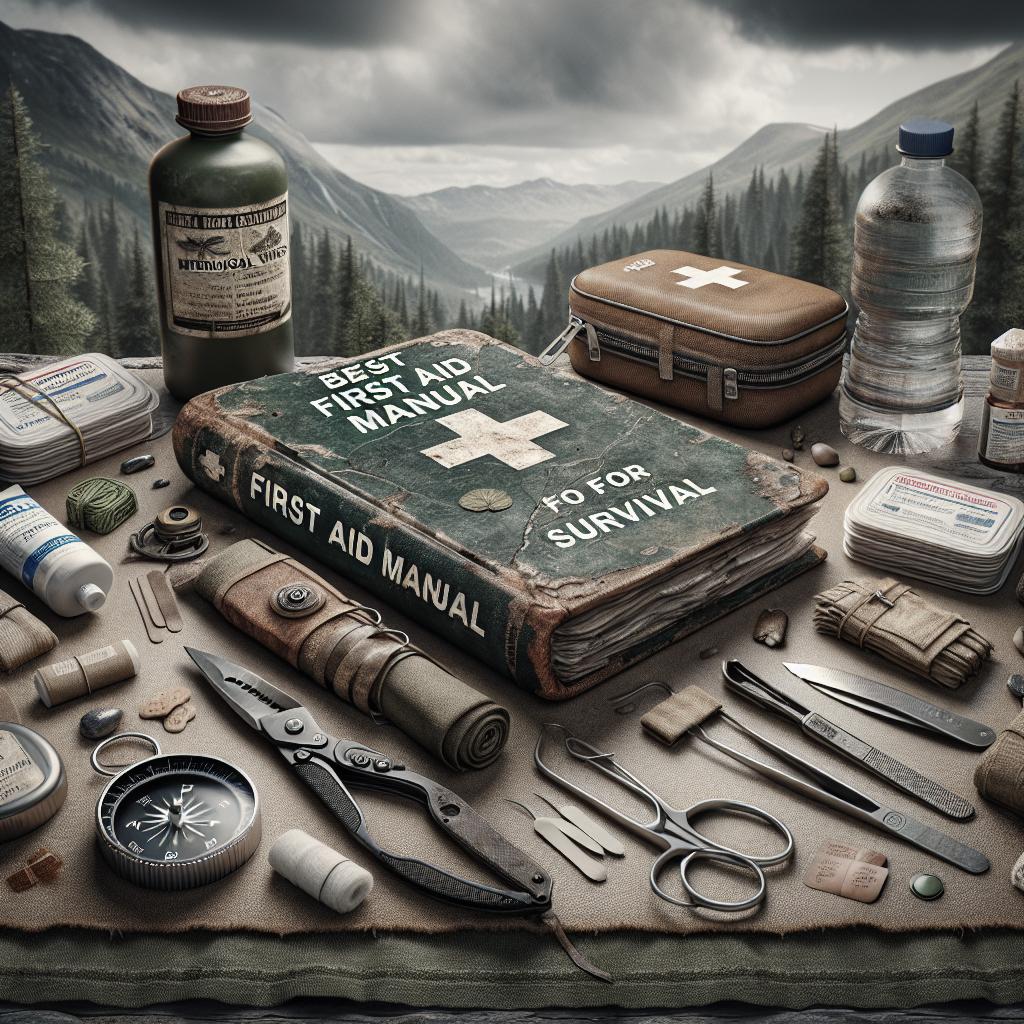<>
When venturing into the wilderness, preparing for emergencies, or simply wanting to be well-equipped to handle unexpected injuries, owning a reliable first aid manual can make all the difference. This blog post explores 22 essential first aid books designed for first aiders, survivalists, and outdoorsmen. Each book offers valuable insights into handling medical emergencies, from conventional first aid techniques to advanced survival medicine. Let’s delve into these comprehensive resources that can empower you to save lives in critical moments. —
Top 22 First Aid Books for First Aiders, Survivalists, & Outdoorsmen
1. First Aid for the USMLE Step 1: A Student to Student Guide
This book is a must-have for medical students preparing for the USMLE Step 1 exam. It’s rich in high-yield review material, concept maps, and mnemonics. The guide provides essential tips from students who’ve already aced the exam, making it an invaluable resource for effective preparation. Beyond exam preparation, it serves as an essential reference for first aid techniques, offering practical knowledge that can be applied in real-life medical scenarios. The clear explanations and organized format make it a go-to manual for students and professionals alike.
2. EMT (Emergency Medical Technician) Crash Course Book + Online (EMT Test Preparation)
A crash course designed for aspiring EMTs, this book covers all you need to know to pass the certification test. It includes concise summaries of crucial material, practice questions, and access to online resources for additional study. The EMT Crash Course not only prepares you for exams but also equips you with vital first aid knowledge. From trauma management to emergency childbirth, it is an extensive guide for those on the front lines of medical emergencies.
3. The Survival Medicine Handbook: A Guide for When Help is NOT on the Way
Written by Joseph and Amy Alton, this handbook is an essential guide for survivalists and preppers. It focuses on medical care during catastrophic scenarios where professional help is unavailable. Topics include handling injuries, infections, and chronic illnesses in austere environments. The book is designed to empower non-medical professionals with the skills to handle emergencies independently. With a focus on practical applications, it provides clear instructions and illustrations to help you manage and treat injuries on your own.
4. Emergency War Surgery: The Survivalist’s Medical Desk Reference
Originally created for military surgeons, this manual is packed with critical surgical techniques and emergency procedures. Its detailed descriptions of battlefield injuries and treatments make it an essential resource for survivalists and emergency responders. It covers a wide range of topics from hemorrhage control to amputation and resuscitation. Whether you’re in a war zone or a remote location, this book delivers in-depth knowledge for handling severe trauma and life-threatening situations.
5. Emergency Care
Renowned for its comprehensive and student-friendly approach, this textbook provides in-depth coverage of emergency medical services. It is widely used in EMT training programs and by first responders, making it a critical resource for those pursuing careers in emergency care. Emergency Care includes detailed explanations, real-life case studies, and practical tips. It covers a broad spectrum of emergencies, from cardiac arrest to environmental injuries, providing readers with the skills they need to respond effectively.
6. Special Operations Forces Medical Handbook
Prepared by the United States Special Operations Command, this handbook is tailored for military medics and paramedics. It covers a wide array of medical procedures and emergency care techniques often encountered in combat situations. The book’s practical approach and extensive coverage make it equally valuable for civilians in extreme environments. Whether you’re dealing with gunshot wounds or performing field surgery, this handbook arms you with the knowledge to manage medical crises effectively.
7. When There Is No Doctor: Preventive and Emergency Healthcare in Uncertain Times (Process Self-reliance Series)
David Werner’s book provides guidance on maintaining health and managing medical issues when professional care is unavailable. With a focus on self-reliance, it emphasizes preventive care and offers practical solutions for various health problems. Filled with illustrations and clear instructions, it’s a valuable resource for anyone in remote areas or during long-term emergencies. From wound care to disease prevention, the book empowers you to handle health issues with limited resources.
8. EMS Field Guide, ALS Version
The EMS Field Guide is a quick reference tool for advanced life support providers. It includes essential information on medications, cardiac rhythms, airway management, and trauma protocols, organized in a compact format for easy access in emergencies. Ideal for paramedics and EMTs, the guide’s straightforward format helps professionals quickly navigate critical information during high-pressure situations. Accuracy and brevity make it a must-have in the field of emergency medical services.
9. Living Ready Pocket Manual – First Aid: Fundamentals for Survival
This pocket-sized manual by James Hubbard serves as a lifesaver when dealing with medical emergencies outdoors. It covers basic first aid, wilderness medicine, and survival strategies in an easy-to-follow format, perfect for carrying in your backpack during trips. The book’s practical tips, combined with its compact size, make it an ideal companion for outdoor enthusiasts and preppers. From treating snake bites to building a first aid kit, it offers essential guidance for survival situations.
10. Wilderness Medicine: Beyond First Aid
Written by William Forgey, this comprehensive guide delves into advanced first aid techniques specific to wilderness settings. It covers a broad range of topics including hypothermia, altitude sickness, and animal attacks, providing outdoor adventurers with essential medical knowledge. The book is designed to equip you with the skills needed to handle medical emergencies far from conventional medical facilities. Its detailed explanations and illustrations ensure you can apply its teachings effectively in real-life scenarios.
11. 2014 Lippincott’s Pocket Drug Guide for Nurses
This compact guide is essential for nurses and healthcare providers who need quick access to drug information. It includes comprehensive listings of more than 1,500 medications, complete with indications, dosing, side effects, and interactions. The guide’s user-friendly format allows for quick reference in clinical settings, ensuring that life-saving information is always at your fingertips. It’s an indispensable tool for managing medication administration accurately and promptly.
12. The Prepper Pages: A Surgeon’s Guide to Scavenging Items for a Medical Kit, and Putting Them to Use While Bugging Out
Pagey Esq.’s book offers practical advice on constructing a medical kit from scavenged items and using them in survival situations. It combines surgical expertise with prepping strategies, providing detailed instructions on how to prepare for and manage medical emergencies. The book emphasizes resourcefulness and ingenuity, teaching readers how to adapt to limited medical supplies. Whether you’re bugging out or facing an emergency, it equips you with the skills to improvise and provide effective medical care.
13. Wound Care (Quickstudy: Health)
For those focused on wound management, this Quickstudy guide provides essential information in an easy-to-read format. It includes the latest techniques and treatments for various types of wounds, from minor cuts to severe injuries. The guide’s concise layout with handy charts and diagrams makes it a useful reference for healthcare providers, first responders, and caregivers. It ensures that you can quickly find the information needed to care for wounds effectively.
14. The American Red Cross First Aid and Safety Handbook
Published by the American Red Cross, this handbook is a trusted resource for learning basic first aid and safety procedures. It covers a wide range of emergencies, from bleeding and burns to CPR and choking. The guideline includes step-by-step instructions and illustrations, making it accessible for both professionals and laypersons. Its comprehensive coverage and authoritative endorsements make it an essential part of any first aid library.
15. American Red Cross First Aid/CPR/AED Participant’s Manual
This participant’s manual is used in American Red Cross training courses, offering detailed guidelines on performing first aid, CPR, and using AEDs. It includes real-life scenarios and interactive exercises to enhance learning. The manual’s structure facilitates easy comprehension and implementation of life-saving techniques. Whether you’re a student or an instructor, it provides a thorough grounding in essential first aid skills.
16. First Aid for Children: A Parents Illustrated Guide to Complete Medical Care of Your Children
Focused on pediatric care, this guide is indispensable for parents and caregivers. It offers detailed instructions on treating common childhood injuries and illnesses, with clear illustrations to aid understanding. The book emphasizes preventive care and safety tips, providing practical advice for keeping children healthy and safe. From dealing with fevers to handling emergencies, it’s a comprehensive resource for child healthcare.
17. Medicine for the Outdoors: The Essential Guide to First Aid and Medical Emergency, 5th Edition
Authored by Paul S. Auerbach, this guide is tailored for outdoor enthusiasts and professionals. It covers a plethora of medical emergencies encountered in remote areas, with detailed procedures and recommendations. The book’s emphasis on prevention and preparedness ensures that readers are equipped to handle unexpected situations. It’s a critical resource for anyone who spends significant time in the wilderness, offering life-saving insights and techniques.
18. SUCCESS! for the Paramedic (4th Edition)
Designed for paramedic students, this book offers comprehensive coverage of the knowledge and skills required to succeed in paramedic programs. It includes practice exams, case studies, and interactive content to solidify understanding. The guide’s structured approach helps students master complex concepts and apply them effectively in emergency scenarios. It’s an invaluable resource for those pursuing careers in emergency medical services.
19. The Merck Manual Home Health Handbook: Third Home Edition
This handbook offers comprehensive medical information for managing health conditions at home. It includes detailed descriptions of diseases, diagnostic criteria, and treatment options, making it a valuable resource for non-professionals. The book’s accessibility and thoroughness make it suitable for dealing with both minor and major health issues. It’s a must-have for anyone looking to better understand and manage their own health and that of their family.
20. EMT-Basic Review Manual For National Certification
This review manual is geared towards those preparing for the EMT-Basic national certification exam. It includes detailed explanations of concepts, practice questions, and test-taking strategies to enhance preparation. The comprehensive coverage ensures that you’re well-prepared for both the written and practical aspects of the exam. It’s an essential resource for aspiring EMTs aiming to achieve certification and excel in their role.
21. First Aid — Responding To Emergencies
This guide is designed for lay responders and first aiders. It covers a broad spectrum of emergencies, providing straightforward instructions on how to respond effectively and administer care until professional help arrives. The book’s user-friendly layout and practical advice make it accessible for individuals with no medical background. It’s an essential resource for workplaces, schools, and community settings.
22. Harrison’s Manual of Medicine: 19th Edition
This condensed version of Harrison’s Principles of Internal Medicine offers a practical reference for healthcare providers. It covers a wide array of medical conditions, diagnostic procedures, and treatments, presented in a straightforward format. The manual is a valuable resource for quick reference in clinical settings, ensuring that you have critical medical information at your fingertips. Its depth and comprehensiveness make it indispensable for medical professionals and students alike. —
More First Aid Resources
Aside from these top-tier first aid manuals, countless other resources can enhance your knowledge and skills in handling emergencies. Online platforms, such as web-based courses and instructional videos, provide additional training and refreshers. Local community organizations often offer workshops and certification programs in first aid and CPR, which can be invaluable. Joining forums and discussion groups can also connect you with a community of like-minded individuals who share tips and experiences.
Other First Aid Books?
While the books listed here provide a robust foundation of first aid knowledge, new publications are constantly emerging. Stay updated by visiting medical and survivalist bookstores, checking reviews, and asking for recommendations from professionals in the field. A good practice is to occasionally review and update your first aid library to include the latest techniques and guidelines. —
| Book | Author | Target Audience | Key Areas Covered |
|---|---|---|---|
| First Aid for the USMLE Step 1 | Vikas Bhushan, Tao Le | Medical Students | Exam Preparation, Medical Knowledge |
| EMT Crash Course | Christopher Coughlin | Aspiring EMTs | Certification Test Preparation, Emergency Techniques |
| The Survival Medicine Handbook | Joseph Alton, Amy Alton | Survivalists, Preppers | Medical Care in Catastrophic Scenarios |
| Emergency War Surgery | U.S. Department of the Army | Survivalists, Military Medics | Surgical Techniques, Trauma Care |
| Emergency Care | Daniel Limmer, Michael F. O’Keefe | EMTs, First Responders | Emergency Medical Services |
| Special Operations Forces Medical Handbook | United States Special Operations Command | Military Medics, Paramedics | Emergency Care, Medical Procedures |
| When There Is No Doctor | David Werner | Remote Area Residents, Preppers | Preventive Care, Handling Medical Issues |
| EMS Field Guide, ALS Version | Informed | Paramedics, EMTs | Medications, Cardiac Rhythms, Airway Management |
| Living Ready Pocket Manual – First Aid | James Hubbard | Outdoor Enthusiasts, Preppers | Basic First Aid, Wilderness Medicine |
| Wilderness Medicine: Beyond First Aid | William Forgey | Outdoor Adventurers | Advanced First Aid, Wilderness Scenarios |
| 2014 Lippincott’s Pocket Drug Guide for Nurses | Amy M. Karch | Nurses, Healthcare Providers | Drug Listings, Dosing, Side Effects |
| The Prepper Pages | Pagey Esq. | Survivalists, Preppers | Scavenging Medical Supplies, Emergency Use |
| Wound Care (Quickstudy: Health) | Unknown | Healthcare Providers, First Aiders | Wound Management Techniques |
| The American Red Cross First Aid and Safety Handbook | American Red Cross | General Public | First Aid Procedures, Safety Tips |
| American Red Cross First Aid/CPR/AED Participant’s Manual | American Red Cross | CPR/First Aid Trainees | First Aid, CPR, AED Use |
| First Aid for Children | Helen McGuigan | Parents, Caregivers | Childhood Injuries, Illnesses |
| Medicine for the Outdoors | Paul S. Auerbach | Outdoor Enthusiasts | Medical Emergencies, Remote Areas |
| SUCCESS! for the Paramedic | Richard A. Cherry, David Page | Paramedic Students | Exam Preparation, Emergency Skills |
| The Merck Manual Home Health Handbook | Mark H. Beers | General Public | Health Conditions, Treatments |
| EMT-Basic Review Manual For National Certification | Stephen J. Rahm | Aspiring EMTs | Certification Test Preparation |
| First Aid — Responding To Emergencies | Staywell | Lay Responders, First Aiders | Emergency Response, First Aid |
| Harrison’s Manual of Medicine | Anthony S. Fauci, et al. | Healthcare Providers, Medical Students | Medical Conditions, Diagnostics, Treatments |


